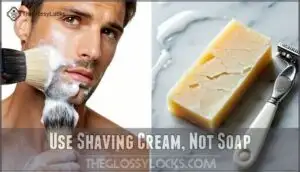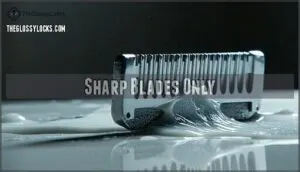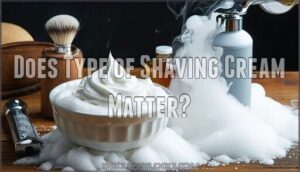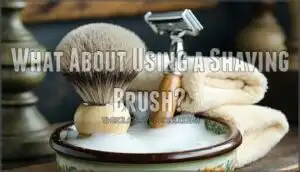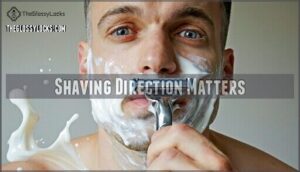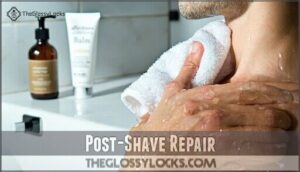This site is supported by our readers. We may earn a commission, at no cost to you, if you purchase through links.
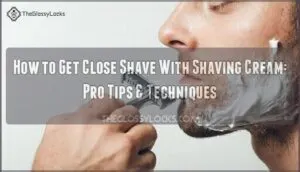
Start with a warm shower to soften facial hair, then apply quality shaving cream in circular motions.
Use a sharp razor and shave with the grain first, then against it for closeness.
Don’t press hard—let the blade do the work.
Rinse your razor frequently and take your time around tricky spots like your chin and jawline.
The key is building a rich, protective lather that cushions your skin while the razor glides smoothly.
Master these basics, and you’ll discover the finer details that separate good shaves from great ones.
Table Of Contents
- Key Takeaways
- How to Get Close Shave With Shaving Cream?
- Shower Before Shaving
- Exfoliate Before Shaving
- Use Shaving Cream, Not Soap
- Mapping Your Hair Growth Pattern
- Sharp Blades Only
- Does Type of Shaving Cream Matter?
- What About Using a Shaving Brush?
- Shaving Direction Matters
- Post-Shave Repair
- Should You Shave in The Shower?
- Frequently Asked Questions (FAQs)
- How do you get a super close shave?
- What is the 3 1 1 rule for shaving cream?
- How to properly shave with shaving cream?
- Why is my razor not getting a close shave?
- Should I use a disposable razor?
- Are metal-handle razors durable?
- How often should I replace my razor?
- What is a shaving brush?
- Should I use balm or gel as aftershave?
- How often should I replace my razor blades?
- Conclusion
Key Takeaways
- You’ll get better results by prepping your skin with a warm shower first – this softens your facial hair and opens pores, making each strand easier to cut and reducing irritation.
- You need to map your hair growth patterns and shave with the grain first, then against it for maximum closeness – this prevents ingrown hairs and razor burn while achieving that smooth finish.
- You can’t skip using sharp blades and quality shaving cream – dull blades drag across your skin causing irritation, while good cream creates a protective lather that lets your razor glide smoothly.
- You should maintain a 30-degree razor angle and use gentle pressure with short strokes – let the blade do the work rather than pressing hard, and rinse your razor frequently to prevent clogging.
How to Get Close Shave With Shaving Cream?
Getting a close shave with shaving cream starts with proper preparation and technique.
Begin with warm water to soften your hair and skin. Apply shaving cream using circular lathering techniques to create rich foam that protects and lubricates.
Hold your razor at a 30-degree razor angle while maintaining proper skin tension by stretching the area you’re shaving. Make multiple passes if needed, starting with the grain and progressing against it for maximum closeness.
To avoid irritation, consider hypoallergenic cream options. Quality cream ingredients like glycerin and natural oils provide superior shaving cream benefits through better glide and moisturization, ensuring your smooth shave results every time.
Shower Before Shaving
Set yourself up for success by starting with a warm shower before shaving. The warm water works like magic for skin softening and pore opening, while hair hydration makes each strand easier to cut.
This time investment pays off with less irritation and smoother results. A vital step involves pre-shave skin cleansing to remove dirt and debris.
Here’s your pre-shave shower checklist:
- Water temperature should be warm, not scalding hot
- Spend 5-10 minutes letting water soften your facial hair
- Massage skin gently to increase blood flow
- Focus on areas you’ll be shaving
- Keep pores open for ideal shaving preparation
Exfoliate Before Shaving
Before applying shaving cream, you’ll want to exfoliate your skin.
This shaving preparation step removes dead cells that can clog your razor and cause irritation. Use gentle circular motions with a mild exfoliant—sugar or coffee grounds work perfectly.
Regular skin exfoliation prevents ingrown hairs and creates a smoother surface. Achieving smooth skin is one benefit.
Skip harsh scrubs if you have skin sensitivity issues.
Use Shaving Cream, Not Soap
Your choice between soap and shaving cream can make or break your close shave. Shaving cream delivers superior cream hydration and protection, while soap’s soaps astringency leaves skin dry and irritated.
Ditch the soap and grab quality shaving cream – your skin will thank you for the upgrade.
Quality shaving cream lather creates a slippery barrier that lets your razor glide smoothly across your face.
Consider these alternative lubricants for your smooth shave:
- Hair conditioner mixed with water creates rich foam
- Body oil provides excellent razor glide
- Homemade creams using coconut oil and shea butter
- Quality shaving cream application with circular motions
Lather quality directly impacts your shaving results and comfort. Some even consider conditioner for shaving, though it has drawbacks.
Mapping Your Hair Growth Pattern
Your beard grows in different directions across your face and neck. Growth pattern analysis reveals this multi-directional growth varies by person.
Creating personalized shaving maps helps you identify these patterns before applying shaving cream. Study your facial hair for a week without shaving to see natural growth directions.
- Map each zone: Draw arrows on a face diagram showing hair direction in different areas.
Understanding your hair growth pattern improves shaving technique and helps achieve a close shave. Directional shaving benefits include avoiding ingrowns and reducing irritation when you follow the grain.
Consistent care can help with itchy beard solutions.
Sharp Blades Only
Since dull blades drag across your skin rather than cut cleanly, sharp blades are your ticket to a close shave without irritation.
Replace blades when you feel tugging or see buildup that won’t rinse away. Your skin sensitivity and hair thickness determine blade lifespan. A key factor is blade material and coating, which directly impacts performance.
| Factor | Impact on Shaving |
|---|---|
| Blade Material | Steel blades stay sharper longer |
| Razor Angle | 30-degree angle prevents cuts |
| Blade Storage | Dry storage prevents rust |
| Blade Lifespan | Replace after 5-7 uses |
| Skin Sensitivity | Sensitive skin needs frequent changes |
Quality shaving cream works best with fresh blades for ideal shaving techniques.
Does Type of Shaving Cream Matter?
You bet the type of shaving cream matters for achieving that perfect close shave.
Traditional creams with quality ingredients create superior lather that softens hair and protects skin better than basic foams. Gel formulations offer excellent razor compatibility and visibility, while cream alternatives work well for sensitive skin types.
The best shaving cream depends on your skin sensitivity and shaving goals. Shaving foams are quick and easy to apply, making them ideal for beginners.
- Choose based on skin type: Dry skin benefits from moisturizing creams, while oily skin works well with lighter gel formulations that provide superior lather quality.
What About Using a Shaving Brush?
A shaving brush transforms your daily routine into something special.
A quality shaving brush elevates your morning ritual from mundane task to luxurious self-care experience.
These tools create superior lather quality compared to hands alone, lifting facial hair for closer cuts.
Different brush types—boar hair, badger hair, or synthetic—offer varying performance levels.
The application technique involves gentle circular motions that provide skin benefits through natural exfoliation.
Using a shaving brush also allows for natural shaving products, avoiding chemical surfactants.
Brush Maintenance
Proper brush maintenance guarantees longevity.
Rinse thoroughly after each use, removing all shaving cream residue.
Store your brush on a stand with bristles facing down.
A shaving bowl helps create that perfect, rich shaving lather every time.
Shaving Direction Matters
The right shaving technique starts with understanding your hair growth pattern and following grain direction for superior results. Your facial hair doesn’t grow uniformly – it follows specific patterns that vary across different areas of your face.
Start by mapping your hair growth to identify the correct shaving direction for each section. Always begin with your first pass following the grain direction, which minimizes irritation and razor burn. For a close shave, you can attempt multiple passes, but reapply shaving cream between each stroke.
Remember to sanitize your razor to prevent bacteria. Consider these essential techniques:
- Maintain proper razor angle at 30 degrees against your skin for maximum cutting efficiency
- Practice skin stretching to create a taut surface, especially around sensitive areas like your neck
- Use gentle pressure to prevent cuts while maintaining shaving effectiveness
Remember, sensitive areas require extra care and patience when adjusting your shaving technique.
Post-Shave Repair
Your post-shave routine can make or break your shaving experience. Rinse your face immediately with cool water to remove leftover shaving cream and close your pores. This simple step helps reduce redness and prevents irritants from entering your skin.
Pat your skin dry with a clean towel—never rub, as freshly shaved skin needs gentle treatment. Rubbing can cause irritation and undo all your careful work.
Next, apply an aftershave balm or soothing balms designed for postshave repair. These products provide essential skin hydration while calming any irritation. For ingrown prevention, choose alcohol-free moisturizing options that won’t sting or dry out your skin.
To further soothe the skin, consider aloe vera applications for their natural healing properties. Don’t skip the moisturizer. A light, hydrating formula maintains skin care after shaving and keeps your face comfortable until your next shave.
If you’re heading outdoors, add sun protection—freshly shaved skin burns easily. Proper skin moisturizing now prevents problems later.
Should You Shave in The Shower?
Taking care of your skin after shaving sets you up for the next decision: where to actually do the deed. Many guys wonder if the shower is the right spot for their daily shave routine.
Shower Shaving Pros include convenience and time-saving benefits. You’re already wet, the steam softens your facial hair, and cleanup happens automatically. Shower Shaving Cons involve reduced visibility and control. You can’t see what you’re doing as clearly, and maintaining proper shaving cream application becomes trickier.
Water Temperature Matters substantially for your results. Hot water opens pores and softens hair, but it can also make your skin too soft, increasing cut risk. Hygiene Considerations favor shower shaving since bacteria wash away immediately.
However, sink shaving allows for better lather control. Slip and Fall Risk increases when handling sharp razors on wet surfaces. Most shaving experts recommend face shaving at the sink for better precision, saving shower shaving for body areas.
- Better visibility and control at the sink
- Steam benefits without safety risks
- Optimal water temperature management
Frequently Asked Questions (FAQs)
How do you get a super close shave?
Prep your skin with warm water for five minutes, apply quality shaving cream.
Shave with the grain first, then against it, use short strokes, rinse your razor frequently.
Finish with cool water.
What is the 3 1 1 rule for shaving cream?
The 3-1-1 rule for shaving cream means using three parts water, one part cream, and one minute of lathering time.
You’ll create the perfect foam consistency that protects your skin while giving maximum lubrication.
How to properly shave with shaving cream?
Skip the rush—proper technique beats speed every time.
Apply warm water first, lather cream thoroughly, shave with grain using short strokes, rinse razor frequently.
Then finish with cool water and moisturizer.
Why is my razor not getting a close shave?
Your razor’s probably dull, clogged with hair and cream, or you’re not prepping properly. Replace that blade, rinse frequently while shaving, and soften your whiskers with warm water first.
Should I use a disposable razor?
Disposable razors can work for close shaves, but they’re typically less effective than multi-blade cartridges or safety razors.
They dull quickly and lack precision.
Consider them for travel convenience, but invest in better options for regular use.
Are metal-handle razors durable?
Like sturdy anchors weathering storms, metal-handle razors deliver exceptional durability that outlasts plastic alternatives by years.
You’ll find they resist drops, maintain balance better, and provide superior grip control for consistently smooth, precise shaves.
How often should I replace my razor?
You should replace your razor every 5-7 shaves or when it starts tugging at hair instead of cutting cleanly.
Dull blades cause irritation and nicks, so don’t push them beyond their prime.
What is a shaving brush?
Think of a shaving brush as your beard’s personal masseuse.
It lifts facial hair upright, works shaving cream deep into whiskers, and creates rich lather for smoother razor glide and better results.
Should I use balm or gel as aftershave?
Choose balm for sensitive or dry skin since it’s gentler and more moisturizing.
Go with gel if you’ve got oily skin or want something lighter that absorbs quickly without leaving residue.
How often should I replace my razor blades?
Sharp blades are your shaving compass—they guide you to smooth results.
You’ll want to swap razor blades every 5-7 shaves or when they start tugging at hair instead of cutting cleanly through it.
Conclusion
Mastering how to get a close shave with shaving cream will absolutely transform your morning routine forever.
You’ll prevent razor burn, eliminate nicks, and achieve professional-level results at home.
Remember to prep your skin with warm water, use quality shaving cream, maintain sharp blades, and follow proper technique.
Don’t rush the process, take time to map your hair growth patterns and shave methodically.
With consistent practice, you’ll develop the skills needed for consistently smooth shaves every single time.


